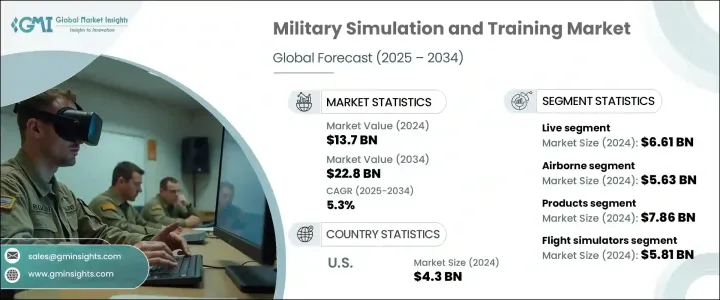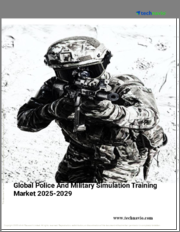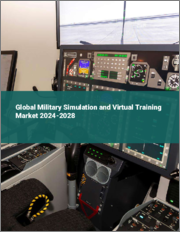
|
시장보고서
상품코드
1750411
군사 시뮬레이션 및 훈련 시장 : 시장 기회, 성장 촉진요인, 산업 동향 분석, 예측(2025-2034년)Military Simulation and Training Market Opportunity, Growth Drivers, Industry Trend Analysis, and Forecast 2025 - 2034 |
||||||
세계의 군사 시뮬레이션 및 훈련 시장은 2024년에는 137억 달러로 평가되었고, CAGR 5.3%로 성장할 전망이며, 2034년까지는 228억 달러에 이를 것으로 추정됩니다.
국방군이 현실적이면서 경제적인 솔루션을 요구하는 가운데 하이테크 시뮬레이션 툴 수요가 급증하고 있습니다. 실전 훈련이 매우 중요하다는 점에는 변함이 없지만 시뮬레이션 플랫폼은 운용상의 위험을 줄이고 장비품 마모와 연료 소비 등 실전 훈련과 관련된 비용을 최소화하는 데 도움이 됩니다.

그러나 과거의 무역 마찰, 특히 중국 전자 제품에 대한 관세는 공급망을 혼란시키고 미국의 방위 계약자의 제조 비용을 상승시켰습니다. 인공지능(AI), 디지털 트윈, 몰입형 AR/VR과 같은 기술의 진보는 군사 시뮬레이션 및 훈련의 상황을 일변시킵니다. 이러한 기술 혁신을 통해 방위 부대는 매우 복잡하고 여러 영역에 걸친 시나리오를 비할 데 없는 리얼리즘과 효율성으로 시뮬레이션할 수 있게 됩니다. AI 주도 훈련 시스템은 사용자의 행동에 적응하고 개인화된 학습 경로를 제공하며 실시간 의사결정 패턴을 기반으로 결과를 예측할 수 있게 되었습니다. 디지털 트윈(물리 시스템의 가상 복제품)에 의해 방위 요원은 장비품, 차량, 환경 전체에서 얻을 수 있는 실시간 데이터와 대화할 수 있게 되어 보다 뛰어난 전략 입안과 작전의 정밀도가 향상됩니다.
| 시장 범위 | |
|---|---|
| 시작 연도 | 2024년 |
| 예측 연도 | 2025-2034년 |
| 시작 금액 | 137억 달러 |
| 예측 금액 | 228억 달러 |
| CAGR | 5.3% |
시뮬레이션 유형별로는 군사 시뮬레이션 및 훈련 시장의 실전 훈련 분야는 2024년에 66억 1,000만 달러를 창출했습니다. 가상 시뮬레이션이나 건설적 시뮬레이션은 진보하고 있지만, 실전 훈련은 진짜 전투 체험을 제공한다는 점에서는 여전히 비할 데 없는 것으로, 동적인 전투 시나리오를 재현하는 데 매우 중요합니다. 또, 공동 훈련 미션이 중시되게 됨에 따라, 대규모 실전 시뮬레이션의 필요성도 높아지고 있으며, 레이저 기반의 무기 대체나 하이브리드 시스템의 혁신에 의해, 그 효과는 높아지고 있습니다.
군사 시뮬레이션 및 훈련 시장에서의 공중 시뮬레이션 부문은 차세대 항공기와 UAV의 도입이 진행되어 복잡한 임무 계획, 어비오닉스 훈련, 고도의 조종용으로 설계된 고도로 전문화된 시뮬레이터에 대한 수요가 높아지고, 2024년에는 56억 3,000만 달러로 평가되었습니다. 비행 운용 비용이 높아지는 가운데 시뮬레이션 기반 훈련은 비용 대비 효과가 높고 효율적인 대체 수단을 제공하며, 특히 정비성이 높은 항공기에서는 기술 개발에 필요한 실제 비행 시간 수를 줄일 수 있습니다.
미국의 군사 시뮬레이션 및 훈련 시장은 2024년에 43억 달러를 창출했으며, 국방비의 대폭적인 증가와 훈련 인프라의 근대화에 대한 중점적인 대처가 그 원동력이 되고 있습니다. 국가는 디지털 트윈 테크놀로지를 통합한 차세대 시뮬레이션 환경 개발을 진행하고 있으며, 보다 정확하고 데이터가 풍부한 준비를 위해 전장 상황을 실시간으로 반영할 수 있습니다. 게다가 합성 환경과 클라우드 베이스의 훈련 에코 시스템을 중심으로 한 대처가 널리 채용되고 있어 부대가 영역을 넘어 복잡한 통합 부대의 시나리오로 결속해 활동할 수 있게 되어 있습니다.
경쟁 구도에서 확고한 지위를 유지하기 위해 Lockheed Martin, Northrop Grumman, BAE Systems, CAE, Collins Aerospace, Saab, Thales, Elbit Systems, Boeing, Rheinmetall, L3Harris Technologies, ST Engineering, Kongsberg Maritime, Indra Sistemas, Leon Interactive Simulations 등 주요 기업은 여러 핵심 전략에 주력하고 있습니다. 방위성과의 제휴, 신흥 시장 진출, AR, AI, VR 기능의 연구개발에 대한 투자 등입니다. 많은 기업들이 기존 시뮬레이터를 업그레이드하고 실시간 데이터와 크로스 도메인 훈련 도구를 접목하고 있으며, 원격 훈련을 위해 클라우드 기반 플랫폼을 통합하고 있는 기업도 있습니다.
목차
제1장 조사 방법 및 범위
제2장 주요 요약
제3장 업계 인사이트
- 업계 생태계 분석
- 트럼프 정권의 관세에 대한 영향
- 무역에 미치는 영향
- 무역량의 혼란
- 보복 조치
- 업계에 미치는 영향
- 공급측의 영향
- 주요 부품의 가격 변동
- 공급망 재구성
- 생산 비용에 미치는 영향
- 수요측의 영향(판매가격)
- 최종 시장에 대한 가격 전달
- 시장 점유율 동향
- 소비자의 반응 패턴
- 공급측의 영향
- 영향을 받는 주요 기업
- 전략적 업계 대응
- 공급망 재구성
- 가격 설정 및 제품 전략
- 정책관여
- 전망 및 향후 검토 사항
- 무역에 미치는 영향
- 업계에 미치는 영향요인
- 성장 촉진요인
- 세계의 국방예산 증가
- 비용 효율적이고 안전한 교육 솔루션에 대한 수요 증가
- 네트워크 중심의 전쟁 교리의 채용
- 무인 시스템(UAV, UGV, USV)의 훈련에 대한 주목의 고조
- VR/AR과 AI의 기술 진보
- 업계의 잠재적 리스크 및 과제
- 높은 초기 투자 비용
- 레거시 시스템과의 복잡한 통합
- 성장 촉진요인
- 성장 가능성 분석
- 규제 상황
- 기술의 상황
- 장래 시장 동향
- 갭 분석
- Porter's Five Forces 분석
- PESTEL 분석
제4장 경쟁 구도
- 서문
- 기업의 시장 점유율 분석
- 주요 시장 기업의 경쟁 분석
- 경쟁 포지셔닝 매트릭스
- 전략 대시보드
제5장 시장 추계 및 예측 : 유형별(2021-2034년)
- 주요 동향
- 라이브
- 가상
- 건설적
제6장 시장 추계 및 예측 : 플랫폼별(2021-2034년)
- 주요 동향
- 육군
- 해군
- 공군
제7장 시장 추계 및 예측 : 솔루션별(2021-2034년)
- 주요 동향
- 제품
- 서비스
제8장 시장 추계 및 예측 : 시뮬레이션 유형별(2021-2034년)
- 주요 동향
- 비행 시뮬레이터
- 차량 시뮬레이터
- 전투 시뮬레이션 시스템
- 커맨드 컨트롤 시뮬레이터
- 기타
제9장 시장 추계 및 예측 : 지역별(2021-2034년)
- 주요 동향
- 북미
- 미국
- 캐나다
- 유럽
- 독일
- 영국
- 프랑스
- 스페인
- 이탈리아
- 네덜란드
- 아시아태평양
- 중국
- 인도
- 일본
- 호주
- 한국
- 라틴아메리카
- 브라질
- 멕시코
- 아르헨티나
- 중동 및 아프리카
- 사우디아라비아
- 남아프리카
- 아랍에미리트(UAE)
제10장 기업 프로파일
- BAE Systems
- Bohemia Interactive Simulations
- CAE
- Collins Aerospace
- Cubic Corporation
- Elbit Systems
- Indra Sistemas
- Kongsberg Maritime
- L3Harris Technologies
- Leonardo DRS
- Lockheed Martin
- Northrop Grumman
- Rheinmetall
- Saab
- ST Engineering
- Textron Systems
- Thales
- The Boeing Company
The Global Military Simulation and Training Market was valued at USD 13.7 billion in 2024 and is estimated to grow at a CAGR of 5.3% to reach USD 22.8 billion by 2034, driven by the rise in defense spending globally, which continues to drive the need for advanced, safe, and cost-efficient training systems. As defense forces seek realistic yet economical solutions, demand for high-tech simulation tools has surged. While live combat drills remain crucial, simulation platforms help reduce operational risks and minimize costs associated with real-life training, such as equipment wear and fuel consumption.

However, past trade tensions, especially tariffs on Chinese electronics, disrupted the supply chain and increased production costs for US defense contractors. Technological advancements like artificial intelligence (AI), digital twins, and immersive AR/VR transform the military simulation and training landscape. These innovations enable defense forces to simulate highly complex, multi-domain scenarios with unparalleled realism and efficiency. AI-driven training systems can now adapt to user behavior, deliver personalized learning paths, and predict outcomes based on real-time decision-making patterns. Digital twins-virtual replicas of physical systems-allow defense personnel to interact with real-time data from equipment, vehicles, or entire environments, facilitating better strategic planning and operational accuracy.
| Market Scope | |
|---|---|
| Start Year | 2024 |
| Forecast Year | 2025-2034 |
| Start Value | $13.7 Billion |
| Forecast Value | $22.8 Billion |
| CAGR | 5.3% |
In terms of simulation type, the live training segment in the military simulation and training market generated USD 6.61 billion in 2024. Although virtual and constructive simulations are advancing, live exercises remain unmatched in delivering authentic combat experiences and are crucial for replicating dynamic battle scenarios. The growing emphasis on joint training missions has also elevated the need for large-scale live simulations, which are becoming more effective with innovations in laser-based weapon substitutes and hybrid systems.
The airborne simulation segment in the military simulation and training market was valued at USD 5.63 billion in 2024, driven by the rising adoption of next-generation aircraft and UAVs has pushed demand for highly specialized simulators designed for complex mission planning, avionics training, and advanced piloting. With flight operations becoming more expensive, simulation-based training offers a cost-effective and efficient alternative, reducing the number of real flying hours needed for skill development, particularly for high-maintenance aircraft.
United States Military Simulation and Training Market generated USD 4.3 billion in 2024, driven by substantial increases in defense spending, coupled with a focused commitment to modernizing training infrastructure. The country is developing next-gen simulation environments integrating digital twin technologies, enabling real-time mirroring of battlefield conditions for more accurate and data-rich preparation. Moreover, initiatives centered on synthetic environments and cloud-based training ecosystems are gaining widespread adoption, ensuring forces to operate cohesively across domains and in complex joint-force scenarios.
To maintain a strong position in the competitive landscape, key companies like Lockheed Martin, Northrop Grumman, BAE Systems, CAE, Collins Aerospace, Saab, Thales, Elbit Systems, Boeing, Rheinmetall, L3Harris Technologies, ST Engineering, Kongsberg Maritime, Indra Sistemas, Leonardo DRS, Cubic Corporation, Textron Systems, and Bohemia Interactive Simulations are focusing on several core strategies. These include partnerships with defense departments, expansion into emerging markets, and investments in R&D for AR, AI, and VR capabilities. Many are upgrading existing simulators to incorporate real-time data and cross-domain training tools, while others are integrating cloud-based platforms for remote training.
Table of Contents
Chapter 1 Methodology and Scope
- 1.1 Market scope and definitions
- 1.2 Research design
- 1.2.1 Research approach
- 1.2.2 Data collection methods
- 1.3 Base estimates and calculations
- 1.3.1 Base year calculation
- 1.3.2 Key trends for market estimation
- 1.4 Forecast model
- 1.5 Primary research and validation
- 1.5.1 Primary sources
- 1.5.2 Data mining sources
Chapter 2 Executive Summary
- 2.1 Industry 360° synopsis
Chapter 3 Industry Insights
- 3.1 Industry ecosystem analysis
- 3.2 Trump Administration Tariffs
- 3.2.1 Impact on Trade
- 3.2.1.1 Trade Volume Disruptions
- 3.2.1.2 Retaliatory Measures
- 3.2.2 Impact on the Industry
- 3.2.2.1 Supply-Side Impact
- 3.2.2.1.1 Price Volatility in Key Components
- 3.2.2.1.2 Supply Chain Restructuring
- 3.2.2.1.3 Production Cost Implications
- 3.2.2.2 Demand-Side Impact (Selling Price)
- 3.2.2.2.1 Price Transmission to End Markets
- 3.2.2.2.2 Market Share Dynamics
- 3.2.2.2.3 Consumer Response Patterns
- 3.2.2.1 Supply-Side Impact
- 3.2.3 Key Companies Impacted
- 3.2.4 Strategic Industry Responses
- 3.2.4.1 Supply Chain Reconfiguration
- 3.2.4.2 Pricing and Product Strategies
- 3.2.4.3 Policy Engagement
- 3.2.5 Outlook and Future Considerations
- 3.2.1 Impact on Trade
- 3.3 Industry impact forces
- 3.3.1 Growth drivers
- 3.3.1.1 Increased defense budgets worldwide
- 3.3.1.2 Rising demand for cost-effective and safe training solutions
- 3.3.1.3 Adoption of network-centric warfare doctrines
- 3.3.1.4 Growing focus on unmanned systems training (UAVs, UGVs, USVs)
- 3.3.1.5 Technological advancements in VR/AR and AI
- 3.3.2 Industry pitfalls and challenges
- 3.3.2.1 High initial investment costs
- 3.3.2.2 Complex integration with legacy systems
- 3.3.1 Growth drivers
- 3.4 Growth potential analysis
- 3.5 Regulatory landscape
- 3.6 Technology landscape
- 3.7 Future market trends
- 3.8 Gap analysis
- 3.9 Porter's analysis
- 3.10 PESTEL analysis
Chapter 4 Competitive Landscape, 2024
- 4.1 Introduction
- 4.2 Company market share analysis
- 4.3 Competitive analysis of major market players
- 4.4 Competitive positioning matrix
- 4.5 Strategy dashboard
Chapter 5 Market Estimates and Forecast, By Type, 2021 – 2034 (USD Million)
- 5.1 Key trends
- 5.2 Live
- 5.3 Virtual
- 5.4 Constructive
Chapter 6 Market Estimates and Forecast, By Platform, 2021 – 2034 (USD Million)
- 6.1 Key trends
- 6.2 Land
- 6.3 Maritime
- 6.4 Airborne
Chapter 7 Market Estimates and Forecast, By Solution, 2021 – 2034 (USD Million)
- 7.1 Key trends
- 7.2 Product
- 7.3 Services
Chapter 8 Market Estimates and Forecast, By Simulation Type, 2021 – 2034 (USD Million)
- 8.1 Key trends
- 8.2 Flight simulators
- 8.3 Vehicle simulators
- 8.4 Combat simulation systems
- 8.5 Command & control simulators
- 8.6 Others
Chapter 9 Market Estimates and Forecast, By Region, 2021 – 2034 (USD Million)
- 9.1 Key trends
- 9.2 North America
- 9.2.1 U.S.
- 9.2.2 Canada
- 9.3 Europe
- 9.3.1 Germany
- 9.3.2 UK
- 9.3.3 France
- 9.3.4 Spain
- 9.3.5 Italy
- 9.3.6 Netherlands
- 9.4 Asia Pacific
- 9.4.1 China
- 9.4.2 India
- 9.4.3 Japan
- 9.4.4 Australia
- 9.4.5 South Korea
- 9.5 Latin America
- 9.5.1 Brazil
- 9.5.2 Mexico
- 9.5.3 Argentina
- 9.6 Middle East and Africa
- 9.6.1 Saudi Arabia
- 9.6.2 South Africa
- 9.6.3 UAE
Chapter 10 Company Profiles
- 10.1 BAE Systems
- 10.2 Bohemia Interactive Simulations
- 10.3 CAE
- 10.4 Collins Aerospace
- 10.5 Cubic Corporation
- 10.6 Elbit Systems
- 10.7 Indra Sistemas
- 10.8 Kongsberg Maritime
- 10.9 L3Harris Technologies
- 10.10 Leonardo DRS
- 10.11 Lockheed Martin
- 10.12 Northrop Grumman
- 10.13 Rheinmetall
- 10.14 Saab
- 10.15 ST Engineering
- 10.16 Textron Systems
- 10.17 Thales
- 10.18 The Boeing Company


















